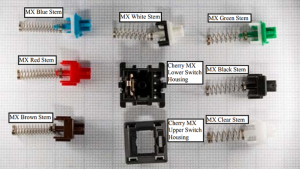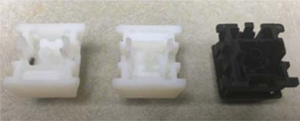According to the US Department of Labor’s Bureau of Labor Statistics, repetitive strain injuries, or RSI, from micro tasks like using a keyboard accounted for employees spending 25,000 hours away from work in 2015. That’s why 3D printed ergonomics for keyboards and other computer accessories are often researched. But, a pair of researchers from Ohio University decided to look into the role of the keyboard’s switch in order to lower the user’s key strike forces as a way to improve ergonomics.
 Alec Peery and Dušan Sormaz from the university’s Russ College of Engineering and Technology wrote a paper, titled “3D Printed Composite Keyboard Switches,” about using 3D printing to explore this new area of keyboard switch design.
Alec Peery and Dušan Sormaz from the university’s Russ College of Engineering and Technology wrote a paper, titled “3D Printed Composite Keyboard Switches,” about using 3D printing to explore this new area of keyboard switch design.
The paper’s abstract reads, “This paper is a demonstration of how 3D printing can be used to create a composite (plastic and rubber) keyboard switch that is ergonomically superior to a traditional injection moulded plastic switch. The prototype switch developed in this project aims to reduce impact forces from keyboard use exerted on user’s fingers by “cushioning” the act of bottoming out the switch during a key press. This concept is significant to industry because it aims to reduce overuse injuries caused from work on computer, a portion of the $20 Billion a year owed in worker compensation in the United States. A commercial Cherry MX keyboard switch has been modified through CAD modelling and 3D printing to incorporate damping regions in the lower half of the switch housing. The switch housings were simultaneously 3D printed with plastic and rubber and their force damping properties were tested with an Arduino UNO microcontroller and force sensing resistor resting on the key tops.”
The most familiar key switch type for most users is a rubber dome switch, but its average life cycle is significantly less than that of mechanical keyboard switches. It’s not component-based either, meaning the rubber sheet that lays across the PCB is the only piece that dictates how the switch feels; mechanical switches allow you to swap the stem and spring to match a user’s preference. Finally, the rubber dome switch can’t be actuated without its conductive material making contact with the PCB below, which means a a bottom out force is transferred to the user every single keystroke – something mechanical switches have improved upon.
The researchers used an Objet350 Connex PolyJet 3D printer for their work, as it allowed them to explore 3D printing a switch that could keep its traditional lower friction plastic guides for smooth actuation but use an elastic base to absorb keystroke impact.
“Thus, the main objective of this paper is to explore the implications of and outcomes of 3D printing a mechanical keyboard switch housing with rubber damping regions to absorb the force of a user over striking the key,” Peery and Sormaz wrote. “This is especially interesting when it is highlighted that the average user employs 2-7 times the necessary force needed to actuate the key.”
They bought commercial models of the switches to help recreate a lower switch housing with damping regions for the stem, cross-sectioned them, and then modeled the altered switches using CAD software, before 3D printing the majority of the switch housing in nylon. The researchers used an Arduino UNO microcontroller and a 10 bit analogue to digital converter, connected to a force sensing resistor (FSR), to create an apparatus to test 3D printed switches with damping regions in the lower housings against commercial switches and 3D printed switches, both with no damping regions.
“In order to simulate a keypress, a 150 gram cylinder of aluminium was dropped from the height of 125mm onto the FSR resting on top of switch stems 30 times for each of the 3 switch configurations. The greater the force transferred from the aluminium cylinder into the FSR, the higher the voltage printed to the console of the Arduino software,” the researchers explained. “The data was then filtered in Excel and sorted from highest to lowest and the highest voltage per drop was saved.”
While confidence in the data is rather lacking, the results did show that an impact force reduction was seen it was expected; Peery and Sormaz wrote that they just need to refine their testing method, and “properly characterize the switches so that more minute changes can be made and confidently detected.”
- Fully assembled switches
- Switch lower housings
“Future testing will incorporate 3 major changes in an attempt to increase the accuracy of the data collected from the sensors and increase the consistency of the simulated key strike,” the researchers explained. “In order to improve the accuracy of sensor readings a more powerful TI c2000 Launchpad microcontroller will be used featuring a 60 MHz clock speed and a 32 bit analog to digital converter[8] compared to the Arduino UNO’s 16 and 10 respectively. To improve the consistency of key strike simulation, the vertical axis of a 3 axis FLX arm robot will be used to strike the key and sensor.”
Discuss this research and other 3D printing topics at 3DPrintBoard.com or share your thoughts below.
Subscribe to Our Email Newsletter
Stay up-to-date on all the latest news from the 3D printing industry and receive information and offers from third party vendors.
You May Also Like
3D Printing News Briefs, April 13, 2024: Robotics, Orthotics, & Hypersonics
In 3D Printing News Briefs today, we’re focusing first on robotics, as Carnegie Mellon University’s new Robotics Innovation Center will house several community outreach programs, and Ugogo3D is now working...
Rail Giant Alstom Saves $15M with 3D Printing Automation Software 3D Spark
3D Spark has entered into a three-year deal with the rail giant Alstom. Alstom, a transport behemoth with annual revenues of $16 billion, specializes in the manufacture of trains, trams,...
Meltio Expands Global Reach with New Partnerships in the Americas and Europe
Spanish 3D printing manufacturer Meltio has expanded its sales network across the globe. With the addition of three new partners in the United States, Brazil, Argentina, and Italy, Meltio aims...
3D Printing Webinar and Event Roundup: April 7, 2024
Webinars and events in the 3D printing industry are picking back up this week! Sea-Air-Space is coming to Maryland, and SAE International is sponsoring a 3D Systems webinar about 3D...




































